4- Way Workstation
Original price was: KSh 105,000.00.KSh 96,000.00Current price is: KSh 96,000.00.
(In Stock)
A 4-way workstation is a type of office furniture designed to accommodate four people in a shared workspace. This setup is common in open-plan offices where collaboration and space efficiency are key considerations. The 4-way workstation is arranged so that each person has their own designated workspace while still being part of a larger, cohesive unit. Here’s a detailed description:
1. Design and Structure:
- Layout:
- Cross Configuration: The most common layout for a 4-way workstation is a cross or “X” shape, where the desks are arranged at right angles to each other. Each workstation is positioned at one of the four ends, creating a symmetrical and balanced design.
- Individual Workspaces: Each of the four workspaces is typically identical, providing equal space and access to shared resources. This ensures that all users have a comfortable and functional area to work in.
- Central Hub: The desks often meet at a central point, which can serve as a hub for shared utilities like power outlets, data ports, or storage compartments.
- Work Surface:
- Spacious Desktops: Each workstation usually has a rectangular or trapezoidal desktop that provides ample space for a computer, paperwork, and other office essentials. The size of each desk can vary but is typically large enough to support comfortable, independent work.
- Materials: The desktops are usually made from durable materials like laminate, wood veneer, or MDF (Medium-Density Fiberboard), designed to withstand daily use. The surfaces are often smooth and easy to clean, with options for different finishes such as wood grain, solid colors, or even glass.
- Cable Management: Integrated cable management systems are common, with channels or grommets that allow wires and cables to be neatly organized and kept out of sight. This feature is particularly important in shared workstations to prevent clutter.
- Partitioning:
- Privacy Screens: To provide a sense of individual space and reduce distractions, each workstation is often separated by privacy screens or panels. These partitions can be made from fabric, frosted glass, or acrylic, and are usually about 12 to 18 inches tall. They offer visual and acoustic separation while still maintaining an open and collaborative environment.
- Height and Transparency: Some partitions are fully opaque for maximum privacy, while others are semi-transparent to allow light to pass through, contributing to a brighter and more open workspace.
2. Storage and Organization:
- Under-Desk Storage: Each workstation may include under-desk storage solutions like pedestal drawers, which provide space for personal items, files, and office supplies. These units often come with lockable drawers for added security.
- Overhead Shelves or Cabinets: In some designs, overhead storage options are available, offering additional space for books, binders, and other materials. These are typically mounted on the partition screens or attached to the desk structure.
- Shared Storage: Centralized storage solutions like shared filing cabinets, shelving units, or cubby holes may be incorporated into the central hub of the workstation, allowing easy access for all users.
3. Materials and Finish:
- Desk Surface: The work surfaces are usually made from high-pressure laminate or melamine, known for their durability and resistance to scratches, stains, and spills. Wood veneer or solid wood finishes are also available for a more upscale look.
- Frame and Legs: The frame and legs of the desks are typically made from metal, such as steel or aluminum, which provides stability and support. The metal is often powder-coated to prevent rust and give a polished appearance.
- Partition Panels: The partitions may be upholstered in fabric, which can be color-coordinated with the rest of the office décor, or made from other materials like acrylic or frosted glass for a modern touch.
4. Ergonomics and Comfort:
- Adjustable Features: Some 4-way workstations offer adjustable desk heights to accommodate different user preferences, promoting ergonomic comfort. Sit-stand desks are also an option in some configurations.
- Legroom: The design ensures ample legroom for each user, with consideration given to the placement of storage units and the central hub.
- Seating Compatibility: The workstations are typically designed to be compatible with standard office chairs, allowing for easy movement and comfort. The open sides of each workstation ensure that chairs can be adjusted freely.
5. Technology Integration:
- Power and Data Access: Many 4-way workstations are equipped with integrated power outlets, USB ports, and data connections within easy reach, often located in the central hub. This facilitates the use of computers, monitors, phones, and other electronic devices without the need for extensive cabling.
- Monitor Arms and Mounts: Some designs include built-in monitor arms or mounts, allowing users to position their screens at the optimal height and angle, further enhancing ergonomic comfort.
6. Aesthetic and Style Options:
- Modern Design: Most 4-way workstations have a sleek, modern design with clean lines and minimalistic features, making them suitable for contemporary office environments.
- Color Options: These workstations come in a variety of colors and finishes, from neutral tones like white, gray, and black to more vibrant hues that can add personality to the office.
- Customizable Elements: Depending on the manufacturer, elements like the color of the partitions, the finish of the desk surface, and the type of storage can often be customized to suit the specific needs and branding of the business.
7. Collaboration and Interaction:
- Open Layout: While the workstations provide individual spaces, the open layout encourages communication and collaboration among team members. This is ideal for teams that need to work closely together on projects.
- Shared Resources: The central hub often serves as a shared space for resources like printers, phones, or communal supplies, further promoting teamwork and efficient use of space.
8. Assembly and Installation:
- Modular Construction: Many 4-way workstations are designed with modular components, allowing for easy assembly and the possibility of reconfiguration if office layouts change in the future.
- Professional Installation: Due to the complexity and size of these workstations, professional installation is often recommended to ensure stability and proper alignment of all components.
9. Applications:
- Office Environments: Ideal for open-plan offices where space efficiency and collaboration are key. It is commonly used in corporate settings, co-working spaces, and start-ups.
- Educational Institutions: Used in computer labs, study areas, or group work environments in schools, colleges, and universities.
- Creative Studios: Suitable for design, architecture, or engineering firms where team members need to work closely together on creative projects.
A 4-way workstation is an efficient and collaborative solution for office spaces where multiple users need to work closely together while still maintaining their individual work areas. Its design promotes both privacy and interaction, making it a versatile choice for various professional settings. The combination of functionality, ergonomic comfort, and modern aesthetics makes the 4-way workstation a popular choice for contemporary office environments


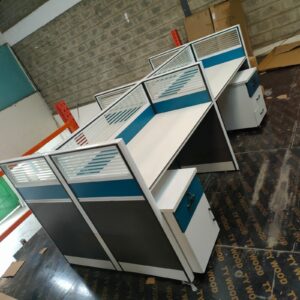
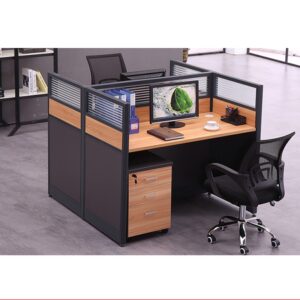
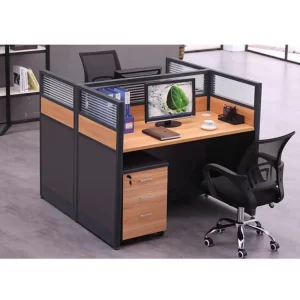
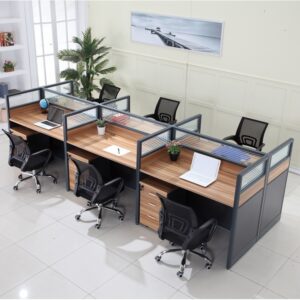
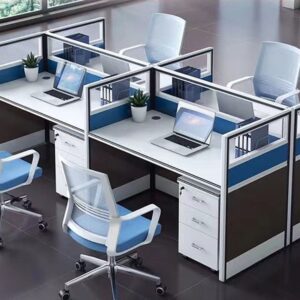
Reviews
There are no reviews yet.